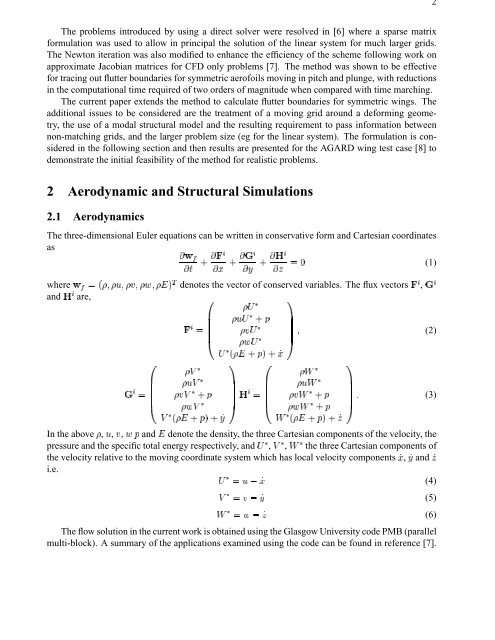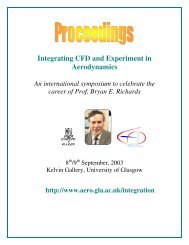IFASD Paper 2003 - CFD4Aircraft
IFASD Paper 2003 - CFD4Aircraft
IFASD Paper 2003 - CFD4Aircraft
You also want an ePaper? Increase the reach of your titles
YUMPU automatically turns print PDFs into web optimized ePapers that Google loves.
In the above , " , % , &U8 and )<br />
<br />
0<br />
0/<br />
0<br />
0<br />
1<br />
#%HD'4I§J8<br />
4 #&KD<br />
<br />
0<br />
0/<br />
0<br />
0<br />
1<br />
O<br />
<br />
C<br />
A A<br />
A<br />
#%¦254<br />
#&:254<br />
<br />
<br />
<br />
0<br />
0/<br />
0<br />
0<br />
1<br />
<br />
A<br />
@BA<br />
A<br />
C<br />
A<br />
#%HOQ4I§J8<br />
4 §98 #&KO<br />
<br />
A A<br />
@<br />
A<br />
A<br />
<br />
<br />
2<br />
<br />
The problems introduced by using a direct solver were resolved in [6] where a sparse matrix<br />
formulation was used to allow in principal the solution of the linear system for much larger grids.<br />
The Newton iteration was also modified to enhance the efficiency of the scheme following work on<br />
approximate Jacobian matrices for CFD only problems [7]. The method was shown to be effective<br />
for tracing out flutter boundaries for symmetric aerofoils moving in pitch and plunge, with reductions<br />
in the computational time required of two orders of magnitude when compared with time marching.<br />
The current paper extends the method to calculate flutter boundaries for symmetric wings. The<br />
additional issues to be considered are the treatment of a moving grid around a deforming geometry,<br />
the use of a modal structural model and the resulting requirement to pass information between<br />
non-matching grids, and the larger problem size (eg for the linear system). The formulation is considered<br />
in the following section and then results are presented for the AGARD wing test case [8] to<br />
demonstrate the initial feasibility of the method for realistic problems.<br />
2 Aerodynamic and Structural Simulations<br />
2.1 Aerodynamics<br />
The three-dimensional Euler equations can be written in conservative form and Cartesian coordinates<br />
¢¡¤£<br />
as<br />
¦¥¨§<br />
©<br />
¦§<br />
<br />
¢§<br />
<br />
(1)<br />
<br />
where ¡£ ¢ !#"$ !#% !#&' (*),+.- denotes the vector of conserved variables. The flux vectors © , <br />
and are,<br />
3254<br />
#"62547§98<br />
(2)<br />
© <br />
254;<br />
@ A<br />
4 ED<br />
#"FDG4<br />
4 EO<br />
#"FOP4<br />
(3)<br />
<br />
<br />
denote the density, the three Cartesian components of the velocity, the<br />
the three Cartesian components of<br />
4<br />
pressure and the specific total energy respectively, and 2 4 , D 4 , O<br />
CTS<br />
DG4;*)L§98M+6§N><br />
OP4R*)§J8M+6§?><br />
the velocity relative to the moving coordinate system which has local velocity ><br />
components > , > and<br />
i.e.<br />
(4)<br />
2 4 L"VW><br />
<br />
4 %XV¨> D<br />
&YV¨> 4<br />
The flow solution in the current work is obtained using the Glasgow University code PMB (parallel<br />
multi-block). A summary of the applications examined using the code can be found in reference [7].<br />
(5)<br />
(6)

















